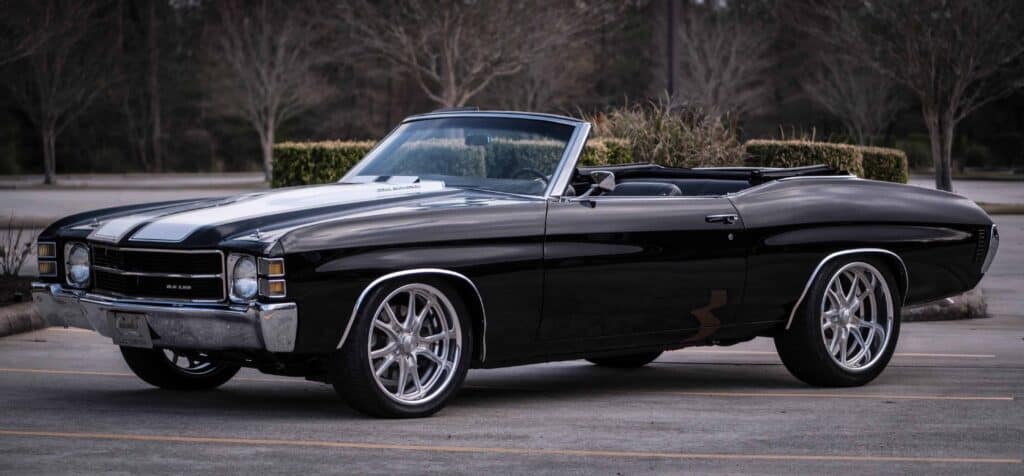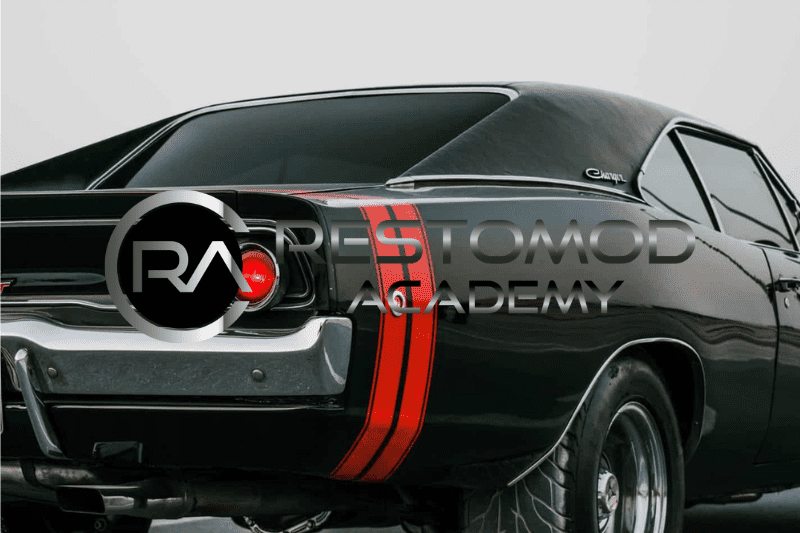Restomod and pro-touring appear in-car features and YouTube videos. These car-building styles look similar but have different names.
If you ask your local hot rod shop to make your family car a pro-tourer, you may get a very different car—and a very different charge.
We’ll show you how to recognize the difference between a pro touring vehicle and a restomod, then show you our finest restomod hot rods.
What Is the Meaning of “Restomod”?
Restomod is a term that combines the words “restoration” and “modified.” Imagine a restomod muscle car as two parts restoration and one part modification, and you’ll be close. Restomods are more restoration than modification, and the non-stock changes are only there to help bring the vehicle up to or close to the driving requirements of a showroom-fresh performance car.
Let’s say your 350-horsepower 1969 Chevelle stopped from 70 mph in 300 feet with its original drum brakes. Your 2015 Camaro stops at 150 feet. In one situation, you may be driving your Chevelle down the highway when the car ahead of you stops. If you restore your Chevelle to factory specs, you may have to rebuild the front end or worse.
This 1969 Chevelle is a ground-up restomod. GM A-body upgrades include brakes, wheels, tires, suspension, and powerplants. The classic manufacturing vibe, and modern capabilities.
The purpose of a restomod is to keep as much of your classic’s original look and feel while improving its performance. In addition, one improves safety and over-the-road performance (economy, comfort, and infotainment) to new-car standards.
Restomods won’t win SCCA races, the Optima Challenge, or the Goodguys autocross circuit, but you may have fun without harming your car. Win with a professional touring car.
Why not restore it instead?

How popular are traditional restorations? Why are classic restorations so popular? Adding modern brakes, tires, chassis components, and safety gear like three-point seatbelts may seem obvious. It’s the lowest choice for most popular cars using reproduction parts (Camaro, Mustang, Chevelle, Challenger, etc. ). A perfect original motorcycle with no modern upgrades is like stepping into a time machine for many. This argues for restoring rather than changing.
The fan who values nostalgia or collectability will choose restoration over restomod and may opt for a “day-two” aesthetic, which allows for adjustments available at the time of construction.
A “day two” restoration would be a 1969 Chevelle with five-slot mag wheels, Cherry Bomb mufflers, and a dual-plane with a Holley double-pump because, while not stock, the original owner could have done them the next day. Day-two restorations are appealing because they tug at the heartstrings as no restomod or pro-touring car can.
The Touring Machine for Professionals
Restomods may look like pro touring cars (g-machines), but there are important variances. A pro touring car has a contemporary wheel/tire package, safer disc brakes, a lower stance with harder springs and performance shocks, an overdrive transmission, and a warmed-up powertrain. Pro-touring is one part restoration and two parts modification, while restomod is the opposite.
“Pro” refers to a vehicle designed for autocross or road course racing, such as the Optima Ultimate Street Car Challenge. Custom chassis and suspension for optimal geometry, on-track safety, and chassis rigidity indicate a competition-oriented shop created the car.
Pro touring cars make little concessions for street driving. Pro Touring cars are streetcars, but they behave and feel more like race cars than a 2020 Camaro.
A restomod 1969 Chevelle may have factory suspension with aftermarket control arms, whereas a pro-touring vehicle might have a modified perimeter-frame chassis from Roadster Shop or Schwartz Performance. This will enhance the budget and establish the framework for more power.
Summary
Whether you’re looking for complete restoration or a full-fledged pro-touring monster, you’ll need to know about the performance hierarchy. Restoration is the process of returning a vehicle to its original state, with no modifications. Then there’s the day-two appearance, which includes simple bolt-ons that were available at the time of construction.
The UPS truck starts delivering bigger boxes to the garage with disc brakes, larger-diameter wheels and tires, higher-output engines, firmer suspensions, and overdrive gearboxes at the restomod level. Your restomod should be nearly as capable as a showroom-fresh performer like a new Camaro SS, Dodge Challenger R/T, Corvette, or Mustang GT at this time.
At A Glance: Restomod vs. Pro Touring
- Affordability. A restomod is usually significantly less expensive than a pro-touring vehicle. It’s also easier to construct in phases.
- Brakes. A restomod’s brake system’s been modified to meet modern passenger car requirements. Race-caliber brakes are standard on a pro-touring machine.
- Tires and wheels Restomods and pro tourers both use larger wheels and tires, but pro tourers are more likely to use a more aggressive rubber formula and lighter, more expensive wheels.
- Chassis. Restomods use simple suspension bolt-on parts that don’t harm or change the factory metal. A serious pro-touring machine’s built from the ground up.
- Suspension. Most older chassis types are extensively maintained by the aftermarket, restomods are a sweet spot for hobbyists. For around a third of the price of a pro-touring vehicle, a few well-chosen bolt-ons can close 80 percent of the handling gap.
- Overdrive. Restomods and pro-touring cars are intended to be driven on the street, an overdrive transmission is essential. Thus, a manual transmission’s nearly usually found in a competitive pro touring car.
- Safety. A restomod will only require the equipment mandated by the Fed in the year of manufacturing because it’s primarily used on the street. A pro-touring machine, on the other hand, may see a lot of action on the track and in other high-speed events like mile racing and open-road racing (Pike’s Peak, Silver State Classic, Big Bend, and so on). Significant safety improvements, such as roll bars or roll cages, fire suppression systems, fire-resistant clothing, helmets, and rollbar cushioning, will be required.
The distinction between pro touring and restomod is explained, as well as why it matters to hot rod and muscle car enthusiasts.


